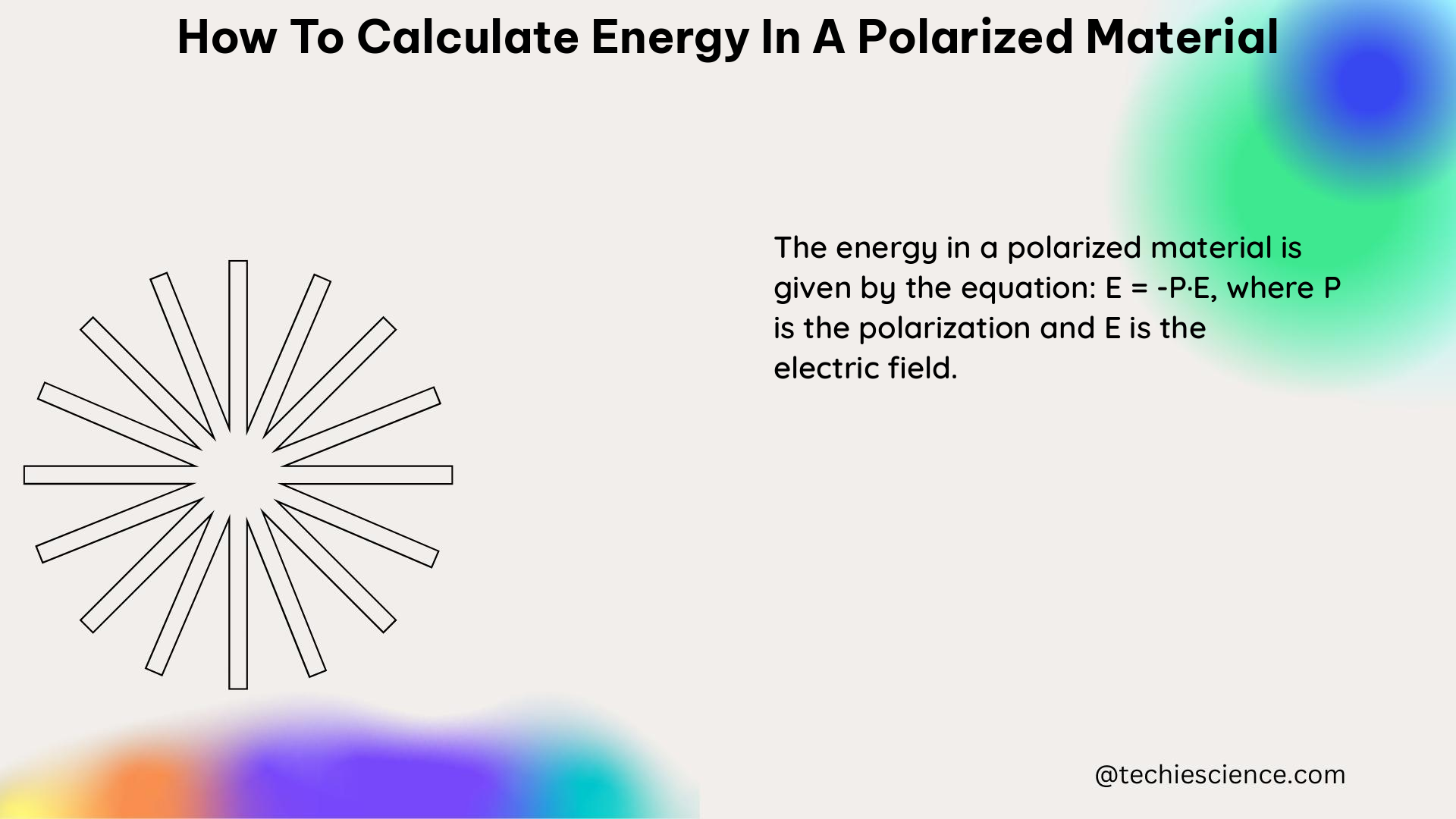Calculating the energy in a polarized material is a crucial task in various fields of physics, from materials science to quantum mechanics. This comprehensive guide will provide you with a deep understanding of the underlying concepts, theoretical frameworks, experimental techniques, and numerical methods to determine the energy in a polarized material.
Understanding Polarization and Polarizability
Polarization is the process by which an electric field induces a dipole moment in a material, leading to the separation of positive and negative charges. Polarizability, on the other hand, is a measure of how easily a material can be polarized. These two concepts are fundamental to understanding the energy in a polarized material.
The relationship between the electric field (E) and the polarization density (P) in a dielectric medium is given by the equation:
E = -P/ε₀
where ε₀ is the permittivity of free space. This equation forms the basis for calculating the local self-energy of a polarized medium, which can be expressed as a function of the polarization density, with different values for longitudinal and transverse polarization.
Theoretical Approaches

Quantum Mechanical Approach
From a quantum mechanical perspective, the energy in a polarized material can be calculated using the eigenstates of the system. The polarization density can be obtained from the layer densities, which are derived from the eigenstates. These layer densities can then be used to calculate the capacitance of the material, providing a way to determine the energy.
Classical Approach
In a classical approach, the energy in a polarized material can be expressed as the sum of the energy of the electric field and the energy due to polarization. This can be formulated using the concept of polarizability, which can be measured experimentally or calculated numerically.
Experimental Techniques
Experimentally, the polarizability of a material can be measured by directly measuring the electric and polarization fields. However, this process is not straightforward, and the theory behind the measurement scheme can vary depending on the type of polarization (longitudinal or transverse).
One common experimental technique is the use of ferroelectric materials, where the polarization can be directly measured. For example, the direct measurement of ferroelectric polarization in a tunable semimetal has been demonstrated, providing insights into the energy in a polarized material.
Numerical Calculations
In addition to theoretical and experimental methods, numerical calculations can also be used to determine the energy in a polarized material. One such approach is the calculation of the capacitance of a material using computed layer densities, potentials, and compressibilities.
Alchemically Polarized Charges (APolQ) Method
When incorporating polarization effects in solvation free energy calculations, the Alchemically Polarized Charges (APolQ) method can be a useful tool. This method employs a standard classical alchemical free energy change simulation to calculate the free energy difference between a system with and without polarization. The APolQ method has been shown to outperform other methods for hydration free energy simulations of organic molecules.
Examples and Numerical Problems
To illustrate the concepts discussed, let’s consider a few examples and numerical problems:
-
Calculating the Polarization Density: Given the electric field (E) and the permittivity of free space (ε₀), determine the polarization density (P) using the equation E = -P/ε₀.
-
Determining the Local Self-Energy: Suppose the polarization density (P) in a material is known. Calculate the local self-energy of the polarized medium, considering both longitudinal and transverse polarization.
-
Measuring Polarizability Experimentally: Design an experimental setup to measure the polarizability of a material by directly measuring the electric and polarization fields. Discuss the challenges and considerations in the measurement scheme.
-
Calculating Capacitance using Numerical Methods: Given the computed layer densities, potentials, and compressibilities of a material, calculate the capacitance of the material and use it to determine the energy in the polarized system.
-
Applying the APolQ Method: Implement the Alchemically Polarized Charges (APolQ) method to incorporate polarization effects in the solvation free energy calculations of an organic molecule. Compare the results with other methods and discuss the advantages of the APolQ approach.
These examples and numerical problems will help you develop a deeper understanding of the concepts and techniques involved in calculating the energy in a polarized material.
Conclusion
Calculating the energy in a polarized material is a complex and multifaceted task that requires a solid understanding of the underlying physics, as well as the ability to apply theoretical, experimental, and numerical methods. This comprehensive guide has provided you with the necessary knowledge and tools to tackle this challenge effectively. By mastering the concepts of polarization and polarizability, and utilizing the various approaches discussed, you will be well-equipped to determine the energy in a polarized material, contributing to advancements in materials science, quantum mechanics, and beyond.
References
- Measurable Quantity – an overview | ScienceDirect Topics
- How do I determine the polarizability of a material? – Physics Stack Exchange
- Direct measurement of ferroelectric polarization in a tunable semimetal
- A Simple Method for Including Polarization Effects in Solvation Free Energy Calculations When Using Fixed-Charge Force Fields
- Polarization Energy – an overview | ScienceDirect Topics

The lambdageeks.com Core SME Team is a group of experienced subject matter experts from diverse scientific and technical fields including Physics, Chemistry, Technology,Electronics & Electrical Engineering, Automotive, Mechanical Engineering. Our team collaborates to create high-quality, well-researched articles on a wide range of science and technology topics for the lambdageeks.com website.
All Our Senior SME are having more than 7 Years of experience in the respective fields . They are either Working Industry Professionals or assocaited With different Universities. Refer Our Authors Page to get to know About our Core SMEs.